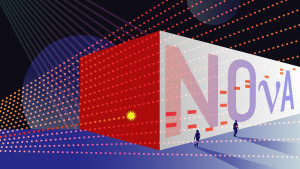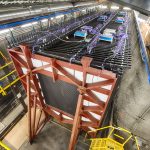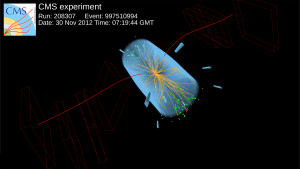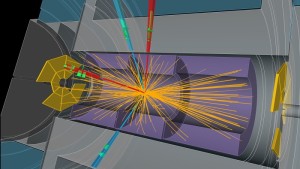
The CMS and ATLAS experiments combined forces to more precisely measure properties of the Higgs boson.
New dwarf galaxy candidates could mean our sky is more crowded than we thought
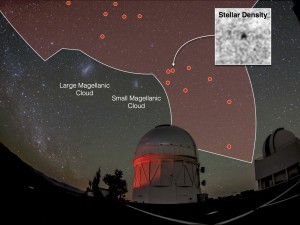
The Dark Energy Survey has now mapped one-eighth of the full sky (red shaded region) using the Dark Energy Camera on the Blanco telescope at the Cerro Tololo Inter-American Observatory in Chile (foreground). This map has led to the discovery of 17 dwarf galaxy candidates in the past six months (red dots), including eight new candidates announced today. Several of the candidates are in close proximity to the two largest dwarf galaxies orbiting the Milky Way, the Large and Small Magellanic Clouds, both of which are visible to the unaided eye. By comparison, the new stellar systems are so faint that they are difficult to “see” even in the deep DES images and can be more easily visualized using maps of the stellar density (inset). Fourteen of the dwarf galaxy candidates found in DES data are visible in this particular image. Illustration: Dark Energy Survey Collaboration
Scientists on the Dark Energy Survey, using one of the world’s most powerful digital cameras, have discovered eight more faint celestial objects hovering near our Milky Way galaxy. Signs indicate that they, like the objects found by the same team earlier this year, are likely dwarf satellite galaxies, the smallest and closest known form of galaxies.
Satellite galaxies are small celestial objects that orbit larger galaxies, such as our own Milky Way. Dwarf galaxies can be found with fewer than 1,000 stars, in contrast to the Milky Way, an average-size galaxy containing billions of stars. Scientists have predicted that larger galaxies are built from smaller galaxies, which are thought to be especially rich in dark matter, the substance that makes up about 25 percent of the total matter and energy in the universe. Dwarf satellite galaxies, therefore, are considered key to understanding dark matter and the process by which larger galaxies form.
The main goal of the Dark Energy Survey (DES), as its name suggests, is to better understand the nature of dark energy, the mysterious stuff that makes up about 70 percent of the matter and energy in the universe. Scientists believe that dark energy is the key to understanding why the expansion of the universe is speeding up. To carry out its dark energy mission, DES takes snapshots of hundreds of millions of distant galaxies. However, some of the DES images also contain stars in dwarf galaxies much closer to the Milky Way. The same data can therefore be used to probe both dark energy, which scientists think is driving galaxies apart, and dark matter, which is thought to hold galaxies together.
Scientists can only see the faintest dwarf galaxies when they are nearby, and had previously only found a few of them. If these new discoveries are representative of the entire sky, there could be many more galaxies hiding in our cosmic neighborhood.
“Just this year, more than 20 of these dwarf satellite galaxy candidates have been spotted, with 17 of those found in Dark Energy Survey data,” said Alex Drlica-Wagner of the U.S. Department of Energy’s (DOE) Fermi National Accelerator Laboratory, one of the leaders of the DES analysis. “We’ve nearly doubled the number of these objects we know about in just one year, which is remarkable.”
In March, researchers with the Dark Energy Survey and an independent team from the University of Cambridge jointly announced the discovery of nine of these objects in snapshots taken by the Dark Energy Camera, the extraordinary instrument at the heart of the DES, an experiment funded by the DOE, the National Science Foundation and other funding agencies. Two of those have been confirmed as dwarf satellite galaxies so far.
Prior to 2015, scientists had located only about two dozen such galaxies around the Milky Way.
“DES is finding galaxies so faint that they would have been very difficult to recognize in previous surveys,” said Keith Bechtol of the University of Wisconsin-Madison. “The discovery of so many new galaxy candidates in one-eighth of the sky could mean there are more to find around the Milky Way.”
The closest of these newly discovered objects is about 80,000 light-years away, and the furthest roughly 700,000 light-years away. These objects are, on average, around a billion times dimmer than the Milky Way and a million times less massive. The faintest of the new dwarf galaxy candidates has about 500 stars.
Most of the newly discovered objects are in the southern half of the DES survey area, in close proximity to the Large Magellanic Cloud and the Small Magellanic Cloud. These are the two largest satellite galaxies associated with the Milky Way, about 158,000 light-years and 208,000 light-years away, respectively. It is possible that many of these new objects could be satellite galaxies of these larger satellite galaxies, which would be a discovery by itself.
“That result would be fascinating,” said Risa Wechsler of DOE’s SLAC National Accelerator Laboratory. “Satellites of satellites are predicted by our models of dark matter. Either we are seeing these types of systems for the first time, or there is something we don’t understand about how these satellite galaxies are distributed in the sky.”
Since dwarf galaxies are thought to be made mostly of dark matter, with very few stars, they are excellent targets to explore the properties of dark matter. Further analysis will confirm whether these new objects are indeed dwarf satellite galaxies and whether signs of dark matter can be detected from them.
The 17 dwarf satellite galaxy candidates were discovered in the first two years of data collected by the Dark Energy Survey, a five-year effort to photograph a portion of the southern sky in unprecedented detail. Scientists have now had a first look at most of the survey area, but data from the next three years of the survey will likely allow them to find objects that are even fainter, more diffuse or farther away. The third survey season has just begun.
“This exciting discovery is the product of a strong collaborative effort from the entire DES team,” said Basilio Santiago, a DES Milky Way Science Working Group coordinator and a member of the DES-Brazil Consortium. “We’ve only just begun our probe of the cosmos, and we’re looking forward to more exciting discoveries in the coming years.”
View the Dark Energy Survey analysis online. Follow the Dark Energy Survey on Facebook and Twitter. For images taken with the Dark Energy Camera, visit the experiment’s photo blog, Dark Energy Detectives.
The Dark Energy Survey is a collaboration of more than 300 scientists from 25 institutions in six countries. Its primary instrument, the 570-megapixel Dark Energy Camera, is mounted on the 4-meter Blanco telescope at the National Optical Astronomy Observatory’s Cerro Tololo Inter-American Observatory in Chile, and its data is processed at the National Center for Supercomputing Applications at the University of Illinois at Urbana-Champaign.
Funding for the DES Projects has been provided by the U.S. Department of Energy Office of Science, the U.S. National Science Foundation, the Ministry of Science and Education of Spain, the Science and Technology Facilities Council of the United Kingdom, the Higher Education Funding Council for England, ETH Zurich for Switzerland, the National Center for Supercomputing Applications at the University of Illinois at Urbana-Champaign, the Kavli Institute of Cosmological Physics at the University of Chicago, Financiadora de Estudos e Projetos, Fundação Carlos Chagas Filho de Amparo à Pesquisa do Estado do Rio de Janeiro, Conselho Nacional de Desenvolvimento Científico e Tecnológico and the Ministério da Ciência e Tecnologia, the Deutsche Forschungsgemeinschaft and the collaborating institutions in the Dark Energy Survey, which can be found at www.darkenergysurvey.org/collaboration.
Fermilab is America’s premier national laboratory for particle physics and accelerator research. A U.S. Department of Energy Office of Science laboratory, Fermilab is located near Chicago, Illinois, and operated under contract by the Fermi Research Alliance LLC. Visit Fermilab’s website at www.fnal.gov and follow us on Twitter at @Fermilab.
The DOE Office of Science is the single largest supporter of basic research in the physical sciences in the United States and is working to address some of the most pressing challenges of our time. For more information, please visit science.energy.gov.
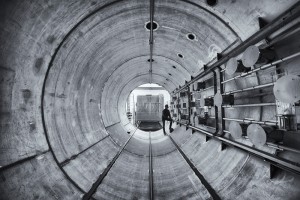
The Fermilab Short-Baseline Neutrino program will use three detectors: SBND, MicroBooNE (shown here) and ICARUS. Photo: Reidar Hahn
In 1995, physicists working on the Liquid Scintillator Neutrino Detector, or LSND, at Los Alamos National Laboratory stumbled upon some curious results.
The experiment, whose goal was to investigate oscillations between the three different flavors of the elusive neutrino, saw evidence that there might be at least one additional flavor of neutrino lurking just out of reach. In 2002, an experiment at Fermilab called MiniBooNE started collecting data to explore this anomaly, but the results were inconclusive: some data seemed to refute the possibility of a fourth neutrino, but other data seemed to indicate particle interactions that couldn’t be explained with conventional three-neutrino models. The possibility of a mysterious, fourth neutrino remained alive.
“It’s a question that’s been first lingering with the anomalies from LSND and then MiniBooNE,” said Bonnie Fleming, co-spokesperson of a new neutrino experiment at Fermilab called MicroBooNE. “There’s now a worldwide campaign to address whether these short-baseline oscillations and hints from other experiments are indicating new physics.”
Scientists from Fermilab and more than 45 institutions around the world have teamed up to design a program to catch this hypothetical neutrino in the act. The program, called the Short-Baseline Neutrino (SBN) program, makes use of a trio of detectors positioned along one of Fermilab’s neutrino beams. Although there are other reactor and source-based experiments in the world that actively seek a fourth neutrino, also called a sterile neutrino, SBN is the only program that uses a particle accelerator to produce neutrinos and multiple neutrino detectors for this search.
“No one else is doing an experiment like this,” said Peter Wilson, coordinator for the SBN program. “There are no other experiments on this energy scale using the concept of a near detector and a far detector.”
Determining whether there are more than three neutrino flavors would affect how scientists interpret data from experiments like the planned Deep Underground Neutrino Experiment, which is expected to make transformative discoveries about neutrinos, and perhaps other aspects of the universe, in the future. Solving the mystery of the anomalies seen at LSND and MiniBooNE, however, will not be easy. Because the sterile neutrino would not interact through the weak nuclear force as the other three do (hence the name “sterile”), detecting this particle would be like chasing the shadow of a ghost.
It begins at the Fermilab Booster, where protons are accelerated to 8 GeV and smashed into a target, creating new particles. Charged particles are bent forward by a magnetic focusing device into a tunnel where most decay to produce muon neutrinos. The three detectors — named the Short-Baseline Near Detector, or SBND, MicroBooNE and ICARUS — will be spread out over a distance of 600 meters. SBND, 100 meters from the target, will take data close to the source to reduce systematic uncertainties by measuring the initial characteristics of the muon neutrino beam. Four hundred meters beyond the planned site for SBND is MicroBooNE, which is already installed. ICARUS will be located 110 meters past MicroBooNE. ICARUS is an existing detector from a previous experiment at the Italian INFN laboratory at Gran Sasso that is currently being refurbished at CERN. It will have a massive chamber holding 760 tons of liquid argon to beat down statistical uncertainties in the experiment.
All three of the detectors are time projection chambers, a type of detector that allows physicists to analyze particle collisions in three dimensions. For these particular TPCs, scientists use liquid argon because its relatively heavy mass ensures a higher rate of interactions.
MicroBooNE received its last fill of liquid argon in July and recently began taking data. Scientists are expecting to break ground on buildings for both ICARUS and SBND by this fall. In 2017, ICARUS will be fully refurbished and delivered to Fermilab. Scientists hope to complete building SBND that same year.
Since experimenters won’t be able to directly detect the sterile neutrino, they will search for clues in the trails of particles the three known neutrino flavors leave behind in the liquid argon after they interact. If the experiments, expected to begin running in 2018, see deviations in the expected neutrino oscillation pattern, scientists will know that they’re on the right track in their hunt for this fugitive particle. If not, they will be able to put the mystery of the sterile neutrino to rest.
“If we design a strong enough experiment, which I believe we have, then one of two things will happen when we start taking data,” said David Schmitz, co-spokesperson for SBND. “Either we will rule out the earlier hints, or we make, frankly, the most exciting discovery in particle physics in some time.”
Scientists on the NOvA experiment saw their first evidence of oscillating neutrinos, confirming that the extraordinary detector built for the project not only functions as planned but is also making great progress toward its goal of a major leap in our understanding of these ghostly particles.
NOvA is on a quest to learn more about the abundant yet mysterious particles called neutrinos, which flit through ordinary matter as though it weren’t there. The first NOvA results, released this week at the American Physical Society’s Division of Particles and Fields conference in Ann Arbor, Michigan, verify that the experiment’s massive particle detector — 50 feet tall, 50 feet wide and 200 feet long — is sitting in the sweet spot and detecting neutrinos fired from 500 miles away. Scientists have sorted through millions of cosmic ray strikes and zeroed in on neutrino interactions.
“People are ecstatic to see our first observation of neutrino oscillations,” said NOvA co-spokesperson Peter Shanahan of the U.S. Department of Energy’s Fermi National Accelerator Laboratory. “For all the people who worked over the course of a decade on the designing, building, commissioning and operating this experiment, it’s beyond gratifying.”
Researchers have collected data aggressively since February 2014, recording neutrino interactions in the 14,000-ton far detector in Ash River, Minnesota, while construction was still under way. This allowed the collaboration to gather data while testing systems before starting operations with the complete detector in November 2014, shortly after the experiment was completed on time and under budget. NOvA construction and operations are supported by the DOE Office of Science.
The neutrino beam generated at Fermilab passes through an underground near detector, which measures the beam’s neutrino composition before it leaves the Fermilab site. The particles then travel more than 500 miles straight through the Earth, no tunnel required, oscillating (or changing types) along the way. About once per second, Fermilab’s accelerator sends trillions of neutrinos to Minnesota, but the elusive neutrinos interact so rarely that only a few will register at the far detector.
When a neutrino bumps into an atom in the NOvA detector, it releases a signature trail of particles and light depending on which type it is: an electron, muon or tau neutrino. The beam originating at Fermilab is made almost entirely of one type — muon neutrinos — and scientists can measure how many of those muon neutrinos disappear over their journey and reappear as electron neutrinos.
If oscillations did not occur, experimenters predicted they would see 201 muon neutrinos arrive at the NOvA far detector in the data collected; instead, they saw a mere 33, proof that the muon neutrinos were disappearing as they transformed into the two other flavors. Similarly, if oscillations did not occur, scientists expected to see only one electron neutrino appearance (due to background interactions). But the collaboration saw six such events, evidence that some of the missing muon neutrinos had turned into electron neutrinos.
Similar long-distance experiments such as T2K in Japan and MINOS at Fermilab have seen these muon neutrino to electron neutrino oscillations before. NOvA, which will take data for at least six years, is seeing nearly equivalent results in a shorter time frame, something that bodes well for the experiment’s ambitious goal of measuring neutrino properties that have eluded other experiments so far.
“One of the reasons we’ve made such excellent progress is the impressive Fermilab neutrino beam and accelerator team,” said NOvA co-spokesperson Mark Messier of Indiana University. “Having a beam of that power running so efficiently gives us a real competitive edge and allows us to gather data quickly.”
Fermilab’s flagship accelerator recently set a high-energy neutrino beam world record when it reached 521 kilowatts, and the laboratory is working on improving the neutrino beam even further for projects such as NOvA and the upcoming Deep Underground Neutrino Experiment. Researchers expect to reach 700 kilowatts early next calendar year, accumulating a slew of neutrino interactions and tripling the amount of data recorded by year’s end.
Neutrinos are the most abundant massive particle in the universe but are still poorly understood. While researchers know that neutrinos come in three types, they don’t know which is the heaviest and which is the lightest. Figuring out this ordering — one of the goals of the NOvA experiment — would be a great litmus test for theories about how the neutrino gets its mass. While the famed Higgs boson helps explain how some particles obtain their masses, scientists don’t know yet how it is connected to neutrinos, if at all. The measurement of the neutrino mass hierarchy is also crucial information for neutrino experiments trying to see if the neutrino is its own antiparticle.
Like T2K, NOvA can also run in antineutrino mode, opening a window to see whether neutrinos and antineutrinos are fundamentally different. An asymmetry early in the universe’s history could have tipped the cosmic balance in favor of matter, making the world we see today possible. Soon, scientists will be able to combine the neutrino results obtained by T2K, MINOS and NOvA, yielding more precise answers about scientists’ most pressing neutrino questions.
“The rapid success of the NOvA team demonstrates a commitment and talent for taking on complex projects to answer the biggest questions in particle physics,” said Fermilab Director Nigel Lockyer. “We’re glad that the detectors are functioning beautifully and providing quality data that will expand our understanding of the subatomic realm.”
The NOvA collaboration comprises 210 scientists and engineers from 39 institutions in the United States, Brazil, the Czech Republic, Greece, India, Russia and the United Kingdom.
For more information, visit the experiment’s website.
Watch live particle events recorded by the NOvA experiment online.
Follow the experiment on Facebook and Twitter.
- The NOvA near detector, built underground at Fermilab in Batavia, Illinois, is roughly 47 feet long, 14 feet high and 10 feet wide. It is constructed of the same material as the far detector. Photo: Fermilab
Note: NOvA stands for NuMI Off-Axis Electron Neutrino Appearance. NuMI is itself an acronym, standing for Neutrinos from the Main Injector, Fermilab’s flagship accelerator. The Fermilab Accelerator Complex is an Office of Science user facility.
Fermilab is America’s premier national laboratory for particle physics and accelerator research. A U.S. Department of Energy Office of Science laboratory, Fermilab is located near Chicago, Illinois, and operated under contract by the Fermi Research Alliance LLC. Visit Fermilab’s website at www.fnal.gov, and follow us on Twitter at @Fermilab.
The DOE Office of Science is the single largest supporter of basic research in the physical sciences in the United States and is working to address some of the most pressing challenges of our time. For more information, please visit science.energy.gov.
Most powerful high-energy particle beam for a neutrino experiment ever generated
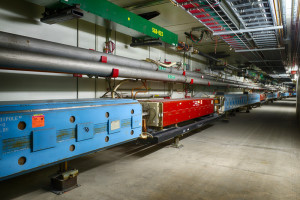
Fermilab’s Main Injector accelerator, one of the most powerful particle accelerators in the world, has just achieved a world record for high-energy beams for neutrino experiments. Photo: Fermilab
A key element in a particle-accelerator-based neutrino experiment is the power of the beam that gives birth to neutrinos: The more particles you can pack into that beam, the better your chance to see neutrinos interact in your detector. Today scientists announced that Fermilab has set a world record for the most powerful high-energy particle beam for neutrino experiments.
Scientists, engineers and technicians at the U.S. Department of Energy’s Fermi National Accelerator Laboratory have achieved for high-energy neutrino experiments a world record: a sustained 521-kilowatt beam generated by the Main Injector particle accelerator. More than 1,000 physicists from around the world will use this high-intensity beam to more closely study neutrinos and fleeting particles called muons, both fundamental building blocks of our universe.
The record beam power surpasses that of the 400-plus-kilowatt beam sent to neutrino experiments from particle accelerators at CERN.
Setting this world record is an initial step for the Fermilab accelerator complex as it will gradually increase beam power over the coming years. The next goal for the laboratory’s two-mile-around Main Injector accelerator — the final and most powerful in Fermilab’s accelerator chain — is to deliver 700-kilowatt beams to the laboratory’s various experiments. Ultimately, Fermilab plans to make additional upgrades to its accelerator complex over the next decade, achieving beam power in excess of 1,000 kilowatts, also referred to as 1 megawatt.
“We have the world’s highest-power beam for neutrinos, and we’re only going up from here,” said Ioanis Kourbanis, head of the Main Injector Department at Fermilab.
Laboratory-made neutrino experiments start by accelerating a beam of particles, typically protons, and then smashing them into a target to create neutrinos. Scientists then use particle detectors to “catch” as many of those neutrinos as possible and record their interactions. Neutrinos rarely engage with matter: Only one out of every trillion emerging from the proton beam will interact in an experiment’s detector. The more particles in that beam, the more opportunities researchers will have to study these rare interactions.
The amped-up particle beam provided by the Main Injector enriches the lab’s neutrino supply, positioning Fermilab to become the primary laboratory for accelerator-based neutrino research. Neutrinos are also made in stars and in the Earth’s core, and they pass through everything — people and planets alike.
“The idea is that if you build a more intense beam, neutrino scientists from around the world will beat a path to your door,” said Fermilab Deputy Director Joe Lykken. “This is exactly what’s happening.”
Fermilab currently operates four neutrino experiments: MicroBooNE, MINERvA, MINOS+ and the laboratory’s largest-to-date neutrino experiment, NOvA, which sends particles from Fermilab’s suburban Chicago location to a far detector 500 miles away in Ash River, Minnesota. The laboratory is working with scientists from around the world on expanding its short-baseline neutrino program and would also serve as host to the proposed flagship Long-Baseline Neutrino Facility and Deep Underground Neutrino Experiment, or DUNE. Scientists aim to address basic questions about the mass and properties of each kind of neutrino as well as the role neutrinos played in the evolution of the universe.
“Reaching this milestone is a fantastic achievement for Fermilab; beam power is everything in our field,” said DUNE co-spokesperson Mark Thomson of the University of Cambridge. “The ability for Fermilab to deliver, yet again, gives the international neutrino community huge confidence in the future U.S.-hosted neutrino program.”
Fermilab is also preparing to operate two experiments for studying muons, short-lived particles that could reveal secrets about the earliest moments of the universe. The increased beam power will also benefit the Fermilab Test Beam Facility, one of the few facilities in the world that provides muons, pions and other particles that researchers can use to test their particle detectors.
Since 2011, Fermilab has made significant upgrades to its accelerators and reconfigured the complex to provide the best possible particle beams for neutrino and muon experiments. With the dedicated work of the Fermilab Accelerator Division, the Main Injector is on track to nearly double its Tevatron-era beam power by 2016.
“Fermilab’s beamline has been a tremendous driver of neutrino science for many years, and the continued improvements to the intensity mean that it will remain a driver for many years to come,” said Indiana University’s Mark Messier, co-spokesperson for the NOvA experiment.
Fermilab is America’s premier national laboratory for particle physics and accelerator research. A U.S. Department of Energy Office of Science laboratory, Fermilab is located near Chicago, Illinois, and operated under contract by the Fermi Research Alliance LLC. Visit Fermilab’s website at www.fnal.gov, and follow us on Twitter at @Fermilab.
The DOE Office of Science is the single largest supporter of basic research in the physical sciences in the United States and is working to address some of the most pressing challenges of our time. For more information, please visit science.energy.gov.
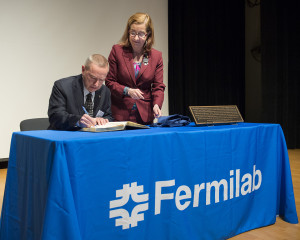
Fermilab Director Nigel Lockyer signs his name in the American Physical Society Register of Historic Sites while Laura Greene, vice president of the APS, looks on. Fermilab was officially designated an APS Historic Site in a ceremony on June 10, 2015 at the laboratory. Photo: Fermilab
The American Physical Society has recognized the U.S. Department of Energy’s Fermi National Accelerator Laboratory as a Historic Site for its nearly five decades of contributions to high-energy physics.
In a ceremony at the laboratory earlier today, Laura Greene, vice president of APS, presented Fermilab Director Nigel Lockyer with a plaque commemorating the lab’s official status as a Historic Site. The plaque reads, in part: “In recognition of Fermi National Accelerator Laboratory for its pivotal contributions to high-energy physics, including the discoveries of the bottom and top quarks and the tau neutrino, key components of the Standard Model.”
“We’re very pleased to receive this official status from the American Physical Society,” Lockyer said. “Fermilab’s bright future is built on a tradition of strong and important work, and it’s great to see that work recognized in this way.”
American Physical Society Historic Sites are chosen by the APS Historic Sites Committee with the goal of raising public awareness of physics and enlightening scientists about important events and places in their field.
“Fermilab has been the home of numerous significant scientific achievements, in addition to being an architecturally impressive facility,” Greene said. “I am truly honored that I will be presenting the plaque signifying Fermilab as an APS Historic Site.”
Fermilab was founded in 1967 under the leadership of its first director, Robert R. Wilson. The 6,800-acre site soon housed the iconic Wilson Hall and the Tevatron, a four-mile-around particle collider that was the laboratory’s flagship physics machine for 25 years.
In 1977, an experiment led by the laboratory’s second director, Leon M. Lederman, discovered the bottom quark, one of 12 known elementary particles that make up the fabric of the universe. In 1995, scientists on the CDF and DZero experiments discovered another of those elementary particles, the top quark. In 2000, scientists on a Fermilab experiment were the first to directly observe the tau neutrino, the long-theorized third type of this ghostly, mysterious particle.
Learn more about the history of Fermilab’s scientific achievements.
Fermilab scientists have been at the forefront of many other important discoveries, including that of the long-sought Higgs boson, found by the CMS and ATLAS collaborations on the Large Hadron Collider at CERN in Switzerland in 2012. More than 100 Fermilab scientists work on the CMS experiment at CERN, and the laboratory serves as the U.S. hub for that experiment, supporting roughly 1,000 university scientists. The LHC has just begun its second run, probing the unknown at the highest energies ever harnessed by mankind.
Fermilab’s current and future physics program includes experiments to unravel the mysteries of the neutrino over long and short distances, experiments to better understand the properties of particles called muons, and an effort to crack the enigma of dark energy, the force believed to be pushing the universe apart faster and faster. Fermilab is also involved in the hunt for the elusive dark matter, which makes up a quarter of our known universe.
The plaque presented to Fermilab today will be placed on display in Wilson Hall. The full text is as follows:
“In recognition of Fermi National Accelerator Laboratory (Fermilab) for its pivotal contributions to high-energy physics, including the discoveries of the bottom and top quarks and the tau neutrino, key components of the Standard Model. Honoring the achievements of Robert R. Wilson, who helped design and establish the lab in 1967 and served as its first director, and Nobel Laureate Leon M. Lederman, who served as its second director and helped inaugurate the Tevatron, the world’s highest energy proton-antiproton collider with the pioneering use of superconducting magnets.”
Fermilab is America’s premier national laboratory for particle physics and accelerator research. A U.S. Department of Energy Office of Science laboratory, Fermilab is located near Chicago, Illinois, and operated under contract by the Fermi Research Alliance LLC. Visit Fermilab’s website at www.fnal.gov and follow us on Twitter at @Fermilab.
The DOE Office of Science is the single largest supporter of basic research in the physical sciences in the United States and is working to address some of the most pressing challenges of our time. For more information, please visit science.energy.gov.
The American Physical Society is a nonprofit membership organization working to advance and diffuse the knowledge of physics through its outstanding research journals, scientific meetings, and education, outreach, advocacy and international activities. APS represents over 51,000 members, including physicists in academia, national laboratories and industry in the United States and throughout the world. Society offices are located in College Park, Maryland (Headquarters), Ridge, New York, and Washington, DC.
Editor’s note: The following news release about upcoming public meetings related to the LBNF/DUNE project was issued by the U.S. Department of Energy and is being hosted on the Fermilab website on its behalf.
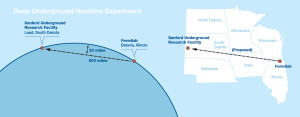
This graphic illustrates the proposed LBNF/DUNE project, which will include construction at Fermilab in Illinois and at Sanford Lab in South Dakota. Image: Fermilab
Public meetings on environmental impacts set for June
The U.S. Department of Energy (DOE) invites interested citizens to review and comment on the possible environmental effects of building and operating the Long-Baseline Neutrino Facility (LBNF) and the associated Deep Underground Neutrino Experiment (DUNE). The experiment will send a beam of neutrinos through the Earth from Fermi National Accelerator Laboratory near Batavia, Illinois, to the Sanford Underground Research Facility in Lead, South Dakota.
DOE’s Draft Environmental Assessment (EA) analyzes the environmental and socioeconomic impacts of the proposed facility. DOE released the draft EA for public review and comment in accordance with the National Environmental Policy Act (NEPA). The comment period on the document is June 8 through July 10. To help people understand the document and start the comment process, DOE will conduct three public meetings:
- June 17 at 6:30 p.m. at Copper Mountain Resort, 900 Miners Ave., Lead, South Dakota
- June 18 at 6:30 p.m. at the Surbeck Center at the South Dakota School of Mines & Technology, 501 E St. Joseph St., Rapid City, South Dakota
- June 24 at 6:30 p.m. in the atrium of Wilson Hall, the main building at Fermilab in Batavia, Illinois
DOE, Sanford Lab and Fermilab will have people available at the meetings to explain the proposed project, the science it plans to accomplish and the specifics of the impacts that are listed in the EA. There are a number of ways people can comment on the document, including:
- At the meeting;
- By U.S. Mail: LBNF/DUNE Comments, U.S. Department of Energy (STS), Fermi Site Office, P.O. Box 2000, Batavia, IL 60510;
- Email: lbnf.comments@science.doe.gov; and
- Online: http://lbnf.fnal.gov/env-assessment.html;
All comments, both oral and written, received during this period will be given equal consideration.
People interested in reviewing, downloading or requesting a copy of the document can view it on the LBNF website at http://lbnf.fnal.gov/files/LBNF-DUNE-Draft-EA.pdf. DOE expects to issue a final EA late this summer.
In Illinois, project leaders plan the construction of four buildings on the Fermilab site, one of which would be about 40 feet high, 160 feet long and located near Kirk Road and Giese Road. That building would be connected via a vertical shaft to an underground hall about 200 feet below the Fermilab site. The project also would include the construction of a 50- to 60-foot-high hill about 1,000 feet from Kirk Road on the Fermilab site as part of the facility that would create the neutrinos.
In South Dakota, project leaders plan the construction of one building at the surface adjacent to an existing building near the Ross Shaft. Approximately one mile underground, the project would include three large caverns, each about 60 feet wide and 500 feet long. These caverns would provide space for utilities and four large detectors filled with liquid argon to detect the neutrinos from Fermilab. Material excavated from the underground to create this space would be delivered to the surface and transported off site. A conveying system would be used on the surface as part of this transportation.
Particle detectors at Sanford Lab would record neutrinos from Fermilab and measure their properties. They also would look for neutrinos from a supernova and search for signs of nucleon decay. With the data, scientists aim to learn more about the building blocks of matter and determine the exact role that neutrinos play in the universe.
Neutrinos, which are also produced by our sun and in the interior of the Earth, are among the most abundant particles in the universe. Fermilab has been operating neutrino-producing facilities for more than 30 years. These include the construction in the early 2000s of a facility that now sends a beam of neutrinos from Fermilab straight through the Earth to Minnesota. The experiments that now use that facility have made important measurements of neutrino properties and how neutrinos interact with other building blocks of matter. The new project would greatly add to that research.
DOE is preparing this environmental assessment to identify and address potential environmental impacts from the proposed action and the range of reasonable alternatives. If significant impacts would result from the construction and operation of the LBNF/DUNE, a more detailed analysis called an Environmental Impact Statement would be undertaken. DOE has explored a number of potential impacts in the draft EA, including:
- Impacts from construction accidents and transportation;
- Impacts to both workers and the public from potential exposure to radiation and other hazards under routine operations and credible accident scenarios;
- Impacts on air, water and soil;
- Socioeconomic impacts; and
- Potential impacts on land-use plans, policies and controls, and visual resources.
Simultaneously, DOE will also be accepting comments on its Draft Programmatic Agreement to address the National Historic Preservation Act which requires DOE to consider the potentially adverse effects of its actions on properties eligible for listing and listed on the National Register of Historic Places. The Draft Programmatic Agreement, which pertains to proposed activities at Sanford Lab, appears in Appendix C2 of the Draft EA.
For additional details about the project, visit the website or contact:
Mike Weis, manager
Fermi Site Office
U.S. Department of Energy Fermi Site Office
P.O. Box 2000
Batavia, Illinois 60510
630-840-2227
michael.weis@science.doe.gov
For general information concerning DOE’s NEPA process, contact:
Peter R. Siebach, NEPA compliance officer
U.S. Department of Energy (STS)
9800 S. Cass Avenue
Argonne, Illinois 60564
630-252-2007
peter.siebach@science.doe.gov
DOE support of this project comes from its Office of Science’s Office of High Energy Physics.
EDITOR’S NOTE: The following news release about the restart of the Large Hadron Collider is being issued by the U.S. Department of Energy’s Fermi National Accelerator Laboratory on behalf of the U.S. scientists working on the LHC. Fermilab serves as the U.S. hub for the CMS experiment at the LHC and the roughly 1,000 U.S. scientists who work on that experiment, including about 100 Fermilab employees. Fermilab is a Tier 1 computing center for LHC data and hosts a Remote Operations Center to process and analyze that data. Read more information about Fermilab’s role in the CMS experiment and the LHC. See a list of Fermilab scientists who can speak about the LHC.
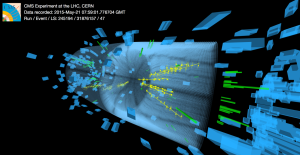
One of the first collisions in the CMS detector at the record-high energy of 13 TeV, taken during testing for the second run of the Large Hadron Collider in late May. Image: CMS/CERN
New LHC data gives researchers from around the world their best chance yet to study the Higgs boson and search for dark matter and new particles
Today scientists at the Large Hadron Collider at CERN, the European research facility, started recording data from the highest-energy particle collisions ever achieved on Earth. This new proton collision data, the first recorded since 2012, will enable an international collaboration of researchers that includes more than 1,700 U.S. physicists to study the Higgs boson, search for dark matter and develop a more complete understanding of the laws of nature.
“Together with collaborators from around the world, scientists from roughly 100 U.S. universities and laboratories are exploring a previously unreachable realm of nature,” said James Siegrist, the U.S. Department of Energy’s associate director of science for high-energy physics. “We are very excited to be part of the international community that is pushing the boundaries of our knowledge of the universe.”
The Large Hadron Collider, the world’s largest and most powerful particle accelerator, reproduces conditions similar to those that existed immediately after the big bang. In 2012, during the LHC’s first run, scientists discovered the Higgs boson—a fundamental particle that helps explain why certain elementary particles have mass. U.S. scientists represent about 20 percent and 30 percent, respectively, of the ATLAS and CMS collaborations, the two international teams that co-discovered the Higgs boson. Hundreds of U.S. scientists played vital roles in the Higgs discovery and will continue to study its remarkable properties.
Scientists will use this new LHC data to pin down properties of the Higgs boson and search for new physics and phenomena such as dark matter particles—an invisible form of matter that makes up 25 percent of the entire mass and energy of the universe. Physicists will also endeavor to answer questions such as: Why is there more matter than antimatter? Why is the Higgs boson so light? Are there additional types of Higgs particles? What did matter look like immediately after the big bang?
“NSF-funded researchers at ATLAS, CMS and LHCb are investigating some of nature’s most fundamental properties at collision energies never before explored. The potential for transformative discoveries is profound,” said Denise Caldwell, NSF’s division director for physics. “We eagerly look forward to LHC operation at almost twice the energy of any other particle accelerator on Earth.”
The LHC was turned off in early 2013, and engineers spent two years preparing the machine to collide particles at a much higher energy and intensity. During the shutdown, U.S. scientists and their international collaborators installed several new components in the four LHC detectors. These components, together with other upgrades, will allow physicists to record more information about the particles produced during the high-energy collisions.
These upgrades included a new detector in the heart of the ATLAS experiment, several new muon detectors on the outer shell of the CMS experiment, a new calorimeter inside the ALICE experiment and an innovative new data sorting system for the LHCb experiment. U.S. scientists played vital roles in the design and instrumentation of these new systems and will operate several of the detector components throughout the next three years of data collection.
Once collected at CERN in Geneva, Switzerland, the new LHC data travels the globe. New fiber optic cables recently installed by the U.S. Department of Energy bring the data to computers and data centers at 18 U.S. institutions, which provide 35 percent of the worldwide computing power for the CMS experiment and 23 percent for the ATLAS experiment.
The upgraded LHC will also generate data at a much faster rate. Scientists predict they will match the amount of data generated throughout the collider’s first three-year run within the next five months, eventually accumulating 10 times more data by the end of 2017. These collisions will also produce Higgs bosons 25 percent faster and will increase the chances of seeing other theoretical particles, such as those predicted for supersymmetry, by over 40 percent.
“The first three-year run of the LHC, which culminated with major discovery in July 2012, was only the start of our journey. It is time for new physics!” said CERN Director-General Rolf Heuer. “We have seen first data beginning to flow. Let’s see what they will reveal to us about how our universe works.”
CERN, the European Organization for Nuclear Research, is the world’s leading laboratory for particle physics. It has its headquarters in Geneva. At present, its Member States are Austria, Belgium, Bulgaria, the Czech Republic, Denmark, Finland, France, Germany, Greece, Hungary, Israel, Italy, the Netherlands, Norway, Poland, Portugal, Slovakia, Spain, Sweden, Switzerland and the United Kingdom. Romania is a Candidate for Accession. Serbia is an Associate Member in the pre-stage to Membership. India, Japan, the Russian Federation, the United States of America, Turkey, the European Union, JINR and UNESCO have Observer Status.
Fermilab is America’s premier national laboratory for particle physics and accelerator research. A U.S. Department of Energy Office of Science laboratory, Fermilab is located near Chicago, Illinois, and operated under contract by the Fermi Research Alliance LLC. Visit Fermilab’s website at www.fnal.gov and follow us on Twitter at @Fermilab.
The DOE Office of Science is the single largest supporter of basic research in the physical sciences in the United States and is working to address some of the most pressing challenges of our time. For more information, please visit science.energy.gov.
The National Science Foundation (NSF) is an independent federal agency that supports fundamental research and education across all fields of science and engineering. In fiscal year (FY) 2015, its budget is $7.3 billion. NSF funds reach all 50 states through grants to nearly 2,000 colleges, universities and other institutions. Each year, NSF receives about 48,000 competitive proposals for funding and makes about 11,000 new funding awards. NSF also awards about $626 million in professional and service contracts yearly.
Two experiments at the Large Hadron Collider at the European Organization for Nuclear Research (CERN) in Geneva, Switzerland, have combined their results and observed a previously unseen subatomic process.
As published in the journal Nature this week, a joint analysis by the CMS and LHCb collaborations has established a new and extremely rare decay of the Bs particle (a heavy composite particle consisting of a bottom antiquark and a strange quark) into two muons. Theorists had predicted that this decay would only occur about four times out of a billion, and that is roughly what the two experiments observed.
“It’s amazing that this theoretical prediction is so accurate and even more amazing that we can actually observe it at all,” said Syracuse University Professor Sheldon Stone, a member of the LHCb collaboration. “This is a great triumph for the LHC and both experiments.”
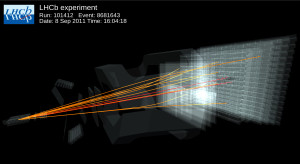
Event displays from the CMS (above) and LHCb (below) experiments on the Large Hadron Collider show examples of collisions that produced candidates for the rare decay of the Bs particle, predicted and observed to occur only about four times out of a billion. Images: CMS/LHCb collaborations
LHCb and CMS both study the properties of particles to search for cracks in the Standard Model, our best description so far of the behavior of all directly observable matter in the universe. The Standard Model is known to be incomplete since it does not address issues such as the presence of dark matter or the abundance of matter over antimatter in our universe. Any deviations from this model could be evidence of new physics at play, such as new particles or forces that could provide answers to these mysteries.
“Many theories that propose to extend the Standard Model also predict an increase in this Bs decay rate,” said Fermilab’s Joel Butler of the CMS experiment. “This new result allows us to discount or severely limit the parameters of most of these theories. Any viable theory must predict a change small enough to be accommodated by the remaining uncertainty.”
Researchers at the LHC are particularly interested in particles containing bottom quarks because they are easy to detect, abundantly produced and have a relatively long lifespan, according to Stone.
“We also know that Bs mesons oscillate between their matter and their antimatter counterparts, a process first discovered at Fermilab in 2006,” Stone said. “Studying the properties of B mesons will help us understand the imbalance of matter and antimatter in the universe.”
That imbalance is a mystery scientists are working to unravel. The big bang that created the universe should have resulted in equal amounts of matter and antimatter, annihilating each other on contact. But matter prevails, and scientists have not yet discovered the mechanism that made that possible.
“The LHC will soon begin a new run at higher energy and intensity,” Butler said. “The precision with which this decay is measured will improve, further limiting the viable Standard Model extensions. And of course, we always hope to see the new physics directly in the form of new particles or forces.”
This discovery grew from analysis of data taken in 2011 and 2012 by both experiments. Scientists also saw some evidence for this same process for the Bd particle, a similar particle consisting of a bottom antiquark and a down quark. However, this process is much more rare and predicted to occur only once out of every 10 billion decays. More data will be needed to conclusively establish its decay to two muons.
The U.S. Department of Energy Office of Science provides funding for the U.S. contributions to the CMS experiment. The National Science Foundation provides funding for the U.S. contributions to the CMS and LHCb experiments. Together, the CMS and LHCb collaborations include more than 4,500 scientists from more than 250 institutions in 44 countries.
Fermilab is America’s premier national laboratory for particle physics and accelerator research. A U.S. Department of Energy Office of Science laboratory, Fermilab is located near Chicago, Illinois, and operated under contract by the Fermi Research Alliance LLC. Visit Fermilab’s website at www.fnal.gov and follow us on Twitter at @Fermilab.
The DOE Office of Science is the single largest supporter of basic research in the physical sciences in the United States and is working to address some of the most pressing challenges of our time. For more information, please visit science.energy.gov.
The National Science Foundation (NSF) is an independent federal agency that supports fundamental research and education across all fields of science and engineering. In fiscal year (FY) 2015, its budget is $7.3 billion. NSF funds reach all 50 states through grants to nearly 2,000 colleges, universities and other institutions. Each year, NSF receives about 48,000 competitive proposals for funding, and makes about 11,000 new funding awards. NSF also awards about $626 million in professional and service contracts yearly.
CERN, the European Organization for Nuclear Research, is the world’s leading laboratory for particle physics. It has its headquarters in Geneva. At present, its Member States are Austria, Belgium, Bulgaria, the Czech Republic, Denmark, Finland, France, Germany, Greece, Hungary, Israel, Italy, the Netherlands, Norway, Poland, Portugal, Slovakia, Spain, Sweden, Switzerland and the United Kingdom. Romania is a Candidate for Accession. Serbia is an Associate Member in the pre-stage to Membership. India, Japan, the Russian Federation, the United States of America, Turkey, the European Union, JINR and UNESCO have Observer Status.

